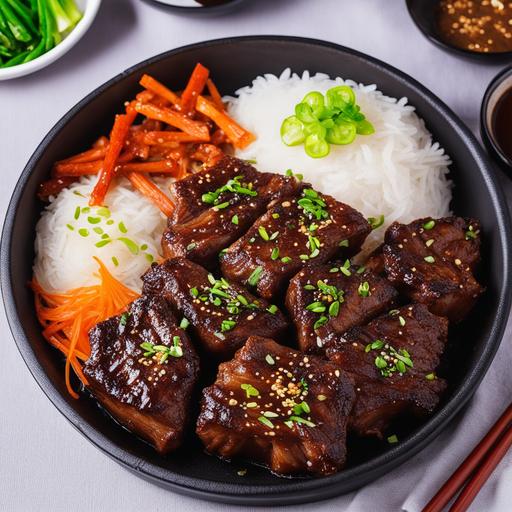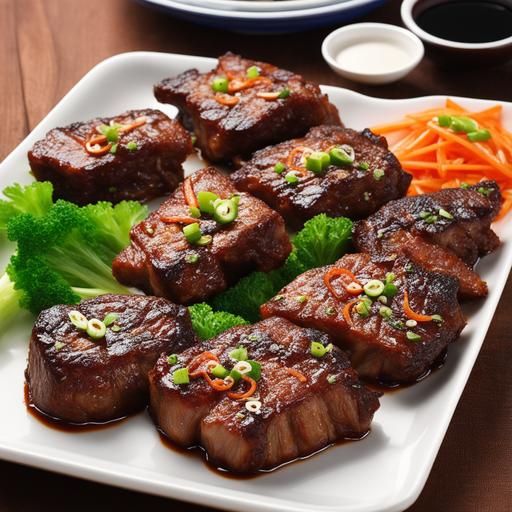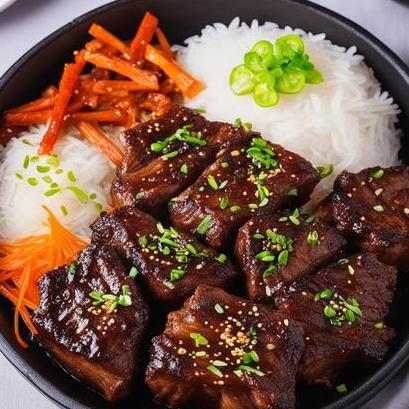
Galbi Oven Recipe: Experience The Delightful Fusion Of Flavors
Are you ready to embark on a culinary journey that will tantalize your taste buds and captivate your senses? Look no further than the delicious and mouthwatering galbi oven recipe. Galbi, derived from the Korean term "갈비," refers to Korean-style short ribs, which are marinated in a flavorsome blend of spices and grilled or baked to perfection. In this comprehensive article, we will delve deep into the world of galbi, exploring food science, culinary details, selection, cleaning, preparation, tips, variations, doneness checks, and more. So, let’s get started!
Food Science Behind Galbi
Before we dive into the details of preparing galbi, it’s crucial to understand the food science that makes this dish so extraordinary. The tenderness and succulence of the short ribs depend on various factors, including the meat’s marbling, connective tissues, and the marinade’s acidity level.
Galbi is typically made with beef short ribs, which have a good amount of intramuscular fat, also known as marbling. This marbling contributes to the rich flavor and juiciness of the cooked meat. When exposed to heat in the oven, the marbling melts, enhancing the overall taste and texture.
Connective tissues, such as collagen, are present in the short ribs as well. However, collagen is relatively tough, making the meat chewy if it’s not cooked properly. Applying heat to the ribs for an extended period helps break down the collagen into gelatin, resulting in tender and flavorful meat.
The marinade’s acidity plays a crucial role in tenderizing the meat. The addition of ingredients like soy sauce, rice wine, and fruits with natural enzymes (e.g., pear or pineapple) helps to break down the muscle fibers, resulting in a more tender and flavorful final product.
Selecting the Perfect Galbi
To ensure a delectable outcome, it is vital to select the right type of short ribs for your galbi oven recipe. You have two main choices when it comes to selecting the right cut:
-
Flanken-style short ribs: These are thinly sliced across the bone, giving you a cross-section of the rib bone within each portion. This cut is ideal for quicker cooking methods like grilling.
-
English-style short ribs: These are longer cuts that include a larger portion of the rib bone. The meat is usually left intact, providing a heartier bite. English-style short ribs are well-suited for slower cooking methods, such as baking in the oven.
Choose a cut that best suits your cooking preferences and the cooking method you plan to employ.
Cleaning and Preparation

Once you have procured the perfect short ribs, it’s time to move on to the cleaning and preparation stage. Proper cleaning ensures the removal of any impurities and allows the flavors to penetrate the meat evenly.
-
Cleaning: Rinse the short ribs under cold running water to remove any bone fragments or excess blood. Pat them dry using paper towels.
-
Marinating: Place the cleaned short ribs in a large container or ziplock bag suitable for marinating. Prepare the galbi marinade by combining soy sauce, rice wine, minced garlic, grated pear, sugar, sesame oil, and black pepper. Pour the marinade over the ribs, ensuring they are completely coated. Seal the container or bag and refrigerate for a minimum of 4 hours, or preferably overnight, to allow the flavors to infuse.
Tips for Galbi Perfection

Cooking galbi to perfection requires a combination of technique and attention to detail. Here are some tips and tricks to ensure that your galbi turns out absolutely delightful:
-
Preheat the oven: Before placing the marinated short ribs in the oven, make sure to preheat it to the recommended temperature. This ensures even cooking and prevents the meat from drying out.
-
Use a wire rack: Placing the marinated ribs on a wire rack instead of directly on the baking tray allows for proper air circulation, resulting in more even browning and crisping of the meat’s exterior.
-
Baste with marinade: During the cooking process, occasionally baste the ribs with the leftover marinade. This not only adds a burst of flavor but also helps keep the meat moist and tender.
-
Monitor the internal temperature: To achieve the desired level of doneness, it is essential to monitor the internal temperature of the ribs using a meat thermometer. For medium-rare, aim for an internal temperature of around 145°F (63°C). Adjust the cooking time if you prefer a different level of doneness.
Variations and Culinary Creativity

Although the classic galbi oven recipe is exquisite in its own right, there are numerous ways to add a personal touch and explore exciting variations. Here are a few suggestions to kickstart your culinary creativity:
-
Sweet and Spicy Galbi: Add a kick to your galbi by incorporating elements of heat. Include gochujang (Korean chili paste) or red pepper flakes to the marinade to infuse that spicy, yet delectable, flavor profile.
-
Teriyaki Galbi: Combine Korean and Japanese cuisines with a teriyaki-inspired marinade. Swap out some of the traditional galbi marinade ingredients with soy sauce, mirin, sake, ginger, and honey. This fusion blend will give your galbi a sweet and savory twist.
-
Citrus-Glazed Galbi: Infuse your galbi with a burst of citrusy freshness. Add freshly squeezed orange or lemon juice, along with zest, to the marinade. The acidity and aroma will elevate the flavors of your galbi.
Remember, these variations are just the tip of the iceberg. Feel free to experiment with different ingredients and flavors to customize your galbi according to your preferences.
Doneness Checks and Avoiding Overcooking or Undercooking

Achieving the perfect level of doneness is crucial when preparing galbi. Overcooking can result in dry and tough meat, while undercooking may lead to an unpleasant, chewy texture. Here are a couple of methods to check for the right doneness:
-
Visual Inspection: Observe the color of the meat. For medium-rare, the interior should appear slightly pink, with a seared and caramelized outer layer.
-
Touch Test: Gently press the meat with your finger. If it feels firm and springs back slightly, it is likely to be medium-rare. However, if the meat feels too soft or mushy, it may indicate that it is undercooked. For a more accurate measurement, use a meat thermometer as mentioned earlier.
It’s better to slightly undercook the galbi and let it rest for a few minutes, allowing the residual heat to finish the cooking process, rather than risk overcooking it.
The Galbi Oven Recipe
Now that we’ve covered the essential aspects of galbi, it’s time to unveil the highly anticipated galbi oven recipe. Follow these steps to achieve galbi perfection:
Ingredients:
-
2 pounds of beef short ribs (flanken or English-style)
-
1/2 cup soy sauce
-
1/4 cup rice wine
-
4 cloves garlic, minced
-
1 small pear, grated
-
2 tablespoons sugar
-
2 tablespoons sesame oil
-
1/2 teaspoon black pepper
Instructions:
-
Clean the short ribs, removing any bone fragments or excess blood. Pat them dry using paper towels.
-
In a mixing bowl, combine the soy sauce, rice wine, minced garlic, grated pear, sugar, sesame oil, and black pepper. Mix until well combined.
-
Place the cleaned short ribs in a suitable container or ziplock bag. Pour the marinade over the ribs, ensuring they are completely coated. Seal the container or bag and refrigerate for a minimum of 4 hours, or preferably overnight.
-
Preheat the oven to 350°F (175°C). Place a wire rack on a baking tray and arrange the marinated short ribs on top.
-
Bake the ribs for approximately 25-30 minutes, or until they reach your desired level of doneness. Baste the ribs with the leftover marinade occasionally to keep them moist.
-
Once cooked, remove the ribs from the oven and let them rest for a few minutes before serving. This allows the flavors to settle and ensures a tender and juicy texture.
-
Serve the galbi alongside steamed rice, kimchi, and other traditional Korean side dishes for an authentic and wholesome meal.
Conclusion
Congratulations, you have now mastered the art of preparing galbi using the versatile and convenient approach of an oven recipe. We explored the food science behind galbi, learned about the selection process, discussed cleaning and preparation techniques, provided useful tips, introduced exciting variations, covered doneness checks, and finally, shared a detailed recipe. With this comprehensive understanding, you are well-equipped to embark on your galbi adventure and create a culinary masterpiece that will leave your taste buds dancing with delight. So, gather your ingredients, preheat that oven, and let the galbi extravaganza begin! Bon appétit!
Sources
FAQS On Galbi Oven Recipe
What Is Galbi And How Is It Traditionally Cooked?
Galbi is a Korean dish made from marinated beef short ribs. Traditionally, it is cooked on a grill or over an open flame to achieve a charred and smoky flavor.
Can I Recreate The Traditional Galbi Flavor Using An Oven?
Yes, you can achieve similar flavors by cooking galbi in the oven. The key is to marinate the meat thoroughly and use high heat to caramelize the sugars in the marinade.
How Long Should I Marinate The Galbi Before Cooking It In The Oven?
It is best to marinate the galbi for at least 4 hours, or preferably overnight, to allow the flavors to fully infuse into the meat.
What Temperature Should I Set The Oven To For Cooking Galbi?
Preheat your oven to 450°F (232°C) to achieve the high heat needed for caramelization and to create a crispy exterior on the galbi.
How Long Does It Take To Cook Galbi In The Oven?
Cooking times can vary depending on the thickness of the meat, but generally, it takes about 20-25 minutes in the oven for the galbi to reach medium-rare doneness. It is important to monitor the cooking process and use a meat thermometer to ensure the desired level of doneness.


